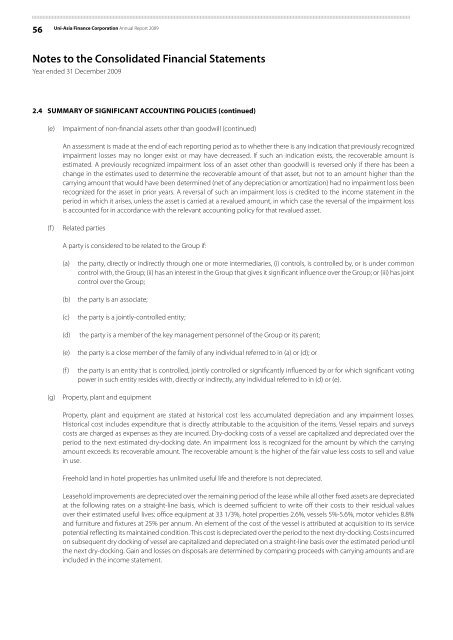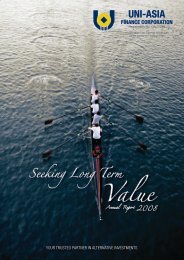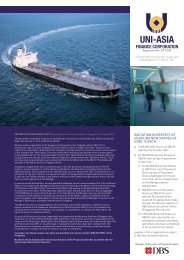Notes to the Consolidated Financial Statements - Uni-Asia Finance ...
Notes to the Consolidated Financial Statements - Uni-Asia Finance ...
Notes to the Consolidated Financial Statements - Uni-Asia Finance ...
Create successful ePaper yourself
Turn your PDF publications into a flip-book with our unique Google optimized e-Paper software.
56<br />
<strong>Uni</strong>-<strong>Asia</strong> <strong>Finance</strong> Corporation Annual Report 2009<br />
<strong>Notes</strong> <strong>to</strong> <strong>the</strong> <strong>Consolidated</strong> <strong>Financial</strong> <strong>Statements</strong><br />
Year ended 31 December 2009<br />
2.4 SUMMARY OF SIGNIFICANT ACCOUNTING POLICIES (continued)<br />
(e)<br />
Impairment of non-financial assets o<strong>the</strong>r than goodwill (continued)<br />
An assessment is made at <strong>the</strong> end of each reporting period as <strong>to</strong> whe<strong>the</strong>r <strong>the</strong>re is any indication that previously recognized<br />
impairment losses may no longer exist or may have decreased. If such an indication exists, <strong>the</strong> recoverable amount is<br />
estimated. A previously recognized impairment loss of an asset o<strong>the</strong>r than goodwill is reversed only if <strong>the</strong>re has been a<br />
change in <strong>the</strong> estimates used <strong>to</strong> determine <strong>the</strong> recoverable amount of that asset, but not <strong>to</strong> an amount higher than <strong>the</strong><br />
carrying amount that would have been determined (net of any depreciation or amortization) had no impairment loss been<br />
recognized for <strong>the</strong> asset in prior years. A reversal of such an impairment loss is credited <strong>to</strong> <strong>the</strong> income statement in <strong>the</strong><br />
period in which it arises, unless <strong>the</strong> asset is carried at a revalued amount, in which case <strong>the</strong> reversal of <strong>the</strong> impairment loss<br />
is accounted for in accordance with <strong>the</strong> relevant accounting policy for that revalued asset.<br />
(f ) Related parties<br />
A party is considered <strong>to</strong> be related <strong>to</strong> <strong>the</strong> Group if:<br />
(a)<br />
(b)<br />
(c)<br />
(d)<br />
(e)<br />
<strong>the</strong> party, directly or indirectly through one or more intermediaries, (i) controls, is controlled by, or is under common<br />
control with, <strong>the</strong> Group; (ii) has an interest in <strong>the</strong> Group that gives it significant influence over <strong>the</strong> Group; or (iii) has joint<br />
control over <strong>the</strong> Group;<br />
<strong>the</strong> party is an associate;<br />
<strong>the</strong> party is a jointly-controlled entity;<br />
<strong>the</strong> party is a member of <strong>the</strong> key management personnel of <strong>the</strong> Group or its parent;<br />
<strong>the</strong> party is a close member of <strong>the</strong> family of any individual referred <strong>to</strong> in (a) or (d); or<br />
(f ) <strong>the</strong> party is an entity that is controlled, jointly controlled or significantly influenced by or for which significant voting<br />
power in such entity resides with, directly or indirectly, any individual referred <strong>to</strong> in (d) or (e).<br />
(g)<br />
Property, plant and equipment<br />
Property, plant and equipment are stated at his<strong>to</strong>rical cost less accumulated depreciation and any impairment losses.<br />
His<strong>to</strong>rical cost includes expenditure that is directly attributable <strong>to</strong> <strong>the</strong> acquisition of <strong>the</strong> items. Vessel repairs and surveys<br />
costs are charged as expenses as <strong>the</strong>y are incurred. Dry-docking costs of a vessel are capitalized and depreciated over <strong>the</strong><br />
period <strong>to</strong> <strong>the</strong> next estimated dry-docking date. An impairment loss is recognized for <strong>the</strong> amount by which <strong>the</strong> carrying<br />
amount exceeds its recoverable amount. The recoverable amount is <strong>the</strong> higher of <strong>the</strong> fair value less costs <strong>to</strong> sell and value<br />
in use.<br />
Freehold land in hotel properties has unlimited useful life and <strong>the</strong>refore is not depreciated.<br />
Leasehold improvements are depreciated over <strong>the</strong> remaining period of <strong>the</strong> lease while all o<strong>the</strong>r fixed assets are depreciated<br />
at <strong>the</strong> following rates on a straight-line basis, which is deemed sufficient <strong>to</strong> write off <strong>the</strong>ir costs <strong>to</strong> <strong>the</strong>ir residual values<br />
over <strong>the</strong>ir estimated useful lives: office equipment at 33 1/3%, hotel properties 2.6%, vessels 5%-5.6%, mo<strong>to</strong>r vehicles 8.8%<br />
and furniture and fixtures at 25% per annum. An element of <strong>the</strong> cost of <strong>the</strong> vessel is attributed at acquisition <strong>to</strong> its service<br />
potential reflecting its maintained condition. This cost is depreciated over <strong>the</strong> period <strong>to</strong> <strong>the</strong> next dry-docking. Costs incurred<br />
on subsequent dry docking of vessel are capitalized and depreciated on a straight-line basis over <strong>the</strong> estimated period until<br />
<strong>the</strong> next dry-docking. Gain and losses on disposals are determined by comparing proceeds with carrying amounts and are<br />
included in <strong>the</strong> income statement.





